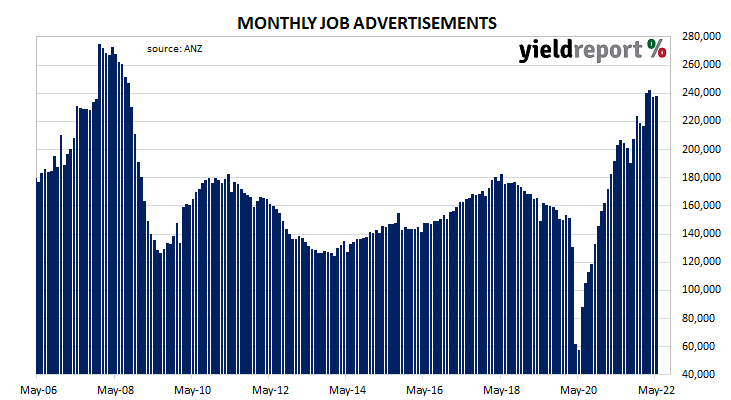Summary: Job ads up 0.4% in May; 17.3% higher than same month in 2021; close to March peak, “significant unmet demand for labour”; “substantial pool” of unutilised labour supply; ads-to-workforce ratio steady at 1.7%, consistent with low jobless rate.
From mid-2017 onwards, year-on-year growth rates in the total number of Australian job advertisements consistently exceeded 10%. That was until mid-2018 when the annual growth rate fell back markedly. 2019 was notable for its reduced employment advertising and this trend continued into the first quarter of 2020. Advertising plunged in April and May of 2020 as pandemic restrictions took effect but then recovered quite quickly.
According to the latest ANZ figures, total advertisements increased by 0.4% in May on a seasonally-adjusted basis. The rise followed a 2.0% decline in April and a 0.8% increase in March after revisions. On a 12-month basis, total job advertisements were 17.3% higher than in May 2021, down from April’s revised figure of 23.6%.
“It [total advertisements] remains close to the March peak, indicating significant unmet demand for labour,” said ANZ senior economist Catherine Birch. However, she pointed to “a substantial pool of domestic labour supply that employers are still not utilising” and noted the job market “is not as tight as in some other economies” such as the US.
The figures were released at roughly the same time as the Melbourne Institute’s latest Inflation Gauge reading but the effect of either on Commonwealth Government bond yields was almost negligible. By the close of business, the 3-year ACGB yield had inched up 1bp to 3.05%, the 10-year yield had returned to its starting point at 3.50% while the 20-year yield finished 1bp lower at 3.79%.
In the cash futures market, expectations of a steeper path for the actual cash rate over time firmed slightly. At the end of the day, contracts implied the cash rate would rise from the current rate of 0.31% to 0.56% in June, rise to 0.92% in July and then increase to 1.335% by August. November contracts implied a 2.43% cash rate while May 2023 contracts implied 3.505%.
The inverse relationship between job advertisements and the unemployment rate has been quite strong (see below chart), although ANZ themselves called the relationship between the two series into question in early 2019. A rising number of job advertisements as a proportion of the labour force is suggestive of lower unemployment rates in the near-future while a falling ratio suggests higher unemployment rates will follow.
In 2008/2009, advertisements plummeted and Australia’s unemployment rate jumped from 4% to nearly 6% over a period of 15 months. When a more dramatic fall in advertisements took place in April 2020, the unemployment rate responded much more quickly.



